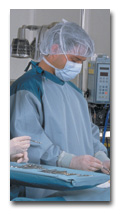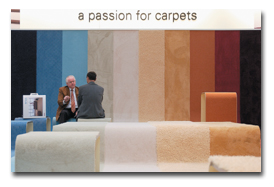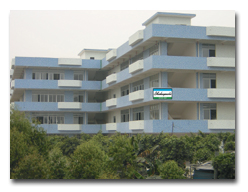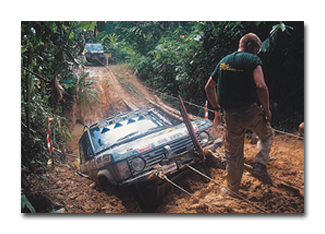
Ropes made of Honeywell Spectra fibers have higher breaking strength than that of steel
wire ropes of the same thickness, but have only one-tenth the weight.
F
or many years, abaca (Manila hemp) and sisal were the dominant rope and cordage fibers;
and there was some use of cotton and jute for small cords, twines and string. Steel wire developed
in the early 1800s for use in heavy-duty cables replaced hemp in heavy-duty uses such as mining and
later in bridge construction.
Vegetable-based hard fibers such as hemp and sisal were the dominant materials for the rope
industry until the late 1930s. The development and introduction of nylon in the late 1930s and
early 1940s provided a new, higher-strength material for the rope industry. Nylon ropes also had
the advantage of resistance to biological degradation. Nylon rope became an important material for
land, sea and air military uses during World War II.
Polypropylene Becomes An Important Material
In the mid-1950s, polyester filament yarns became available and found some use in rope
applications because they possess a lower elongation than nylon. The initial higher price of
polyester filament restricted its use on a larger scale. At about the same time, polyethylene and
polypropylene began to be used in rope and cordage products. An advantage of these polyolefins in
rope is their low specific gravity, which enables them to float. Polyethylene use in rope is
restricted because of its low melting point.
After 1957, a number of US and European companies began to produce polypropylene resin. This
enabled many rope manufacturers to extrude their own fibers and yarns for their rope and cordage
products.
Polypropylene For Baler Twine
Farm equipment was developed in the 1930s that would collect and tie grain with sisal twine.
Supplies of sisal and the varying quality of the sisal twine presented problems for the farmers.
Polypropylene twine was introduced for baling in the 1960s. Major advantages of this twine over
sisal twine were that its higher strength and rot resistance enabled the bales to be moved more
easily and to be stored outside. Quality problems with early polypropylene baler twine slowed its
early acceptance as a replacement for wire products. The first polypropylene twine used degraded
when exposed to sunlight. This problem was overcome by adding ultraviolet (UV) inhibitors to the
polymer before extrusion. A major improvement in polypropylene baler twine was made when Albert
Lea, Minn.-based Bridon Cordage developed its SR-240 product in 1977.
“Our twine performed much better than steel wire back then, and, even to date, our technology
and manufacturing process continues to keep our Bridon brand the worlds premier baler twine
product,” said Al Mullenbach, marketing and sales manager. Bridon Cordage is owned by Eagan,
Minn.-based Universal Cooperatives Inc., an international farm supply cooperative that is owned and
operated by members around the globe. The company has plants in Jerome, Idaho, and Saskatchewan. It
also produces polypropylene cordage and twine for industrial uses.
Another important producer of polypropylene baler twine and industrial twine is Ontario-based
Poli-Twine Inc. Poli-Twine claims the following advantages for its Power-Ty baler twine:
suitability for use in all heavy-duty balers, generally without the need for knotter modification;
UV treatment for extended outdoor storage; and capability of making tight knots without
slippage.
High-Tech Rope And Cable Manufacturing
Until man-made fibers and high-performance fibers became available, rope manufacturers products
were used by traditional businesses such as marine transportation and shipping, fishing and mining.
Some smaller companies specialized in ropes and cordage for yachting and recreational boating. When
nylon fibers and later when high-performance fibers came on the scene, rope and cordage companies
were able to produce higher-strength products, which opened up new, more demanding markets. These
markets required rope manufacturers to increase their technical staffs and perform more research
and development work. This also resulted in a considerable amount of merger and consolidation in
the rope industry. Important newer applications for cordage products include fiber optic armored
cables, marine and aerospace cables, steel replacement ropes and transport slings.
High-Performance Fibers For Ropes And Cordage
Kevlar® aramid fiber is a liquid crystal polymer first marketed by Wilmington, Del.-based DuPont
in 1971. The long-chain polymer is extremely rigid and produces fibers of very high strength – five
times stronger ounce-for-ounce than steel with half the density of fiberglass. Kevlar’s very high
strength – up to 27 grams per denier – and its low elongation enable it to be used in special types
of cable. It was used to secure the airbags in the landing apparatus of the Mars Pathfinder. Kevlar
is not found in ropes used in everyday marine applications, not only because of its relatively high
price, but also because its abrasion resistance and UV resistance are only fair. One type of
specialty cable for yacht rigging is made by using a continuous loop of Kevlar rope to create a
super-strong, lightweight cable that is protected from UV rays and abrasion by a heat-shrink
covering and a chafe cover with customized thimbles at each end.
Kevlar is useful for small guys to very large marine anchor ropes and helicopter slings. It is
used in electromechanical cables that carry both load and conductors, such as power transmission
lines, undersea communications systems and fiber optic cables, among others. In most cable and rope
applications, Kevlar is used in combination with other materials. Loose tube cables used for aerial
applications and in underground ducts use Kevlar as a strength member to withstand mechanical
pulling and other stress during installation and use. There are a large number of color-coded
optical cables within the tubes. The tube cables are of an all-dielectric construction, and the
interstices and the Kevlar are gel-flooded to provide extra water protection. These types of cables
have a wide operating temperature range and excellent reliability in a wide variety of installation
environments.
Kevlar-reinforced fiber optic telemetry cables are operated off medium and large oceanographic
vessels for marine geological and geophysical programs. In a system that has been used to examine
the volcanic seafloor off the coast of Hawaii, the business end of the sea cable consists of two
separate modules – one for initial power conversion and optical encoding/decoding and another that
houses lights, cameras and other environmental sensors. The power module is attached directly to
the end of the electro-optical tether. The camera module hangs below it on a 15-meter-long
Kevlar-reinforced coaxial umbilical. The camera module has one video module and two 500-watt
incandescent lights, and a small pressure case to hold communication and power distribution
circuits. The power module contains an oil-filled transformer case that supplies 110-volt current
and a pressure case for optical encoding of data. This system has operated at depths of 800
meters.
The Cordage Institute
Founded in 1920, the Wayne, Pa.-based Cordage Institute is an international association of
manufacturers, producers and resellers of cordage, rope and twine. The institute’s more than 70
members, including 10 from outside the United States, represent about 70 percent of the poundage of
these products produced and used in the United States. The institute’s technical committee is
involved in the development of standards and guidelines standardized using a voluntary consensus
process for the manufacture and use of cordage, rope and twine products. The committee publishes a
manual that documents the safe use of these products.
For more information about the Cordage Institute, contact (610) 971-4854; fax (610) 971-4859;
info@ropecord.com;
www.ropecord.com.
Gel-Spun Polyethylene Fibers
Polyethylene found only limited use in fiber structures until researchers at DSM Research, The
Netherlands, developed the gel fiber process for making high-strength polyethylene fibers using an
ultra-high-molecular-weight polyethylene fiber dissolved in a suitable hydrocarbon solvent at a
suitable temperature and concentration.
In 1984, AlliedSignal Inc., now the Colonial Heights, Va.-based Advanced Fibers and Composites
business unit of Honeywell International Inc., Morris Township, N.J., licensed DSM’s patents and
technology to produce gel-spun high-strength polyethylene fibers, using the technology to develop
Spectra® fibers, now known as Honeywell Spectra. AlliedSignal made further improvements, which
resulted in newer generations of Spectra.
In 1986, DSM formed a joint venture with Toyobo Co. Ltd., Japan, to produce DSM’s Dyneema®
high-strength polyethylene fibers.
Rope And Related Uses For Dyneema® and Spectra®
Although produced by two different companies, Dyneema and Spectra share very similar properties
and end-use applications. Ropes made from these products have a higher breaking strength than that
of steel wire ropes of the same thickness, but have only one-tenth the weight. These ropes have
good UV, seawater, abrasion, cutting and fatigue resistance. With their low specific gravity, they
also float. Fishing uses for these high-strength polyethylene ropes include warp lines, bridles,
headlines and rib lines. Netting uses include trawl nets, purse seine nets and aquaculture nets.
The low diameter of these twines and their favorable weight/strength ratio produce up to 40-percent
less drag than conventional fiber structures as the net is pulled through the water or set against
tide currents. This allows fishing vessels to increase their catch potentially by as much as 80
percent by trawling faster or using larger nets, or to reduce fuel consumption. The resistance of
Dyneema nets to UV light, seawater, abrasion and cutting is high, guaranteeing that nets last
longer, according to DSM. With low elongation as little as 5 percent and no shrinkage in water, the
mesh size remains stable during normal use of the netting.
Other important applications of high-strength polyethylene fibers are cut-resistant gloves,
bullet-resistant vests and plates for personal protection, vehicle armor, yacht ropes and sails,
and rescue and climbing cables.
Vectran® Liquid Crystal Polymer Fiber
Fort Mill, S.C.-based Celanese Advanced Materials Inc.’s Vectran® a high-performance
thermoplastic multifilament yarn spun from Vectra® liquid crystal polymer (LCP) is the only
commercially available melt-spun LCP fiber in the world. Pound for pound, Vectran fiber is five
times stronger than steel and 10 times stronger than aluminum. The unique properties that
characterize Vectran fiber include:
- high strength and modulus;
- excellent creep resistance;
- high abrasion resistance;
- excellent flex/fold characteristics;
- low thermal expansion coefficient;
- minimal moisture absorption;
- high dielectric strength;
- outstanding cut resistance;
- excellent property retention at high and low temperatures;
- outstanding vibration-damping characteristics; and
- high impact resistance.
Vectran HS is helping to solve performance problems in critical marine, military and
industrial rope and cable applications. For example, in July 1997, airbags made from Vectran fabric
were deployed to cushion the landing on Mars of the Pathfinder space probe.
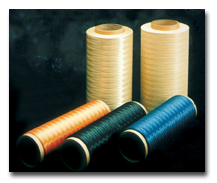
Celanese Advanced Materials’ Vectran® thermoplastic filament yarn – spun from Vectra®
liquid crystal polymer (LCP) – is the only commercially available meltspun LCP fiber in the
world.
Applications for Vectran rope products include towing and cargo tie-downs. The rope’s
high-strength, no-creep and low-stretch properties make it ideal for these uses. Vectran ropes have
found acceptance as yacht halyards, and they maintain sail loads under varying wind conditions.
Although there is no one high-performance fiber that meets all of the requirements for ropes and
cables, Vectran’s properties provide the greatest versatility, according to Celanese. Although
Vectran is lacking in UV resistance, this limitation can be overcome by using polyester as a
protective covering. It also is possible that suitable polymer additives may soon be developed to
improve its UV resistance.
April 2005

